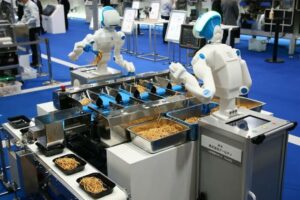Japan is very famous for making robots and other Artificial intelligence tools. Japan has had its own identity of making reliable and prestigious electronic products for decades.
Japanese Robotics still produce “amazing papers” and are very present” in the research community, says Manuela Veloso, head of artificial intelligence research at investment bank JPMorgan Chase.
One of Japan’s most natural advantages in robotics is an abiding love of Machines. Japan has a strong history of belief that objects, places and creatures possess a spiritual essence.
“Many Japanese people think that everything has a soul, then why not robots?” said Minoru Asada.
Early Adopters
Japan is the one that started developing industrial robots in 1960. In 1980, many large companies entered the industry, and Japan became known as a “robot superpower”, stated Yasuyoshi Yokokohji, a mechanical engineer at Kobe University.
Later, Japan set its sights on humanoid robots, popular with Honda’s Asimo, unveiled in 2000.”Nobody else was producing any robots at the time, but Japan was making them”, Veloso says.
However, in 2010, Japan was falling behind Boston dynamics, a robotics company in Massachusetts that developed humanoid robots and Universal robots, a company located in Odense, Denmark.
In addition, the robots were user-friendly programming interfaces and more flexible applications. “Compared to that, the programming interfaces made by Japanese robot companies were only for experts”, says Akihiko Yamaguchi, director and founder of FingerVision-a robotics startup in Tokyo, China.
Though, in 2012, the technology emergence and AI entrance changed the whole world. AI technologies work as deep learning and neural networks around the world. AI research began needing “massive computers and huge amounts of data”, said Ishiguro.

Need For Innovation
Most Japanese researchers continued to bring inventions to robots. Eventually, the implementation of Advanced AI technologies started to merge with robotics. “AI and robotics are not separate”, Asada says. Massive changes happen, and we need to accept it”.
Language is another barrier for Japanese Robotics, as not all robotic experts are proficient in English.
“It can be difficult because a lot of excellent Research in Japan is in Japanese”, says Woodrow Hartzog, an expert in technology law at Boston University in Massachusetts.
Furthermore, many robotics labs in Japan are concentrating on “developing robots simply because they want to develop robots, without thinking about applications”, Yokokohji said.
As per Yokokohji, it is a good start. The country still lacks a more consistent long-term strategy to promote robotics research.
Hence, continuous support will help Japanese Robotics experts to play to their strengths within the broader international field, says Asada.
In addition, Japan is still a leader in developing complex mechanical parts. Whereas many researchers around the world currently work in the digital realm.
Japan can be a leader in cutting down the gap between and software, becoming a leader in making intelligent, humanoid robots and other types of interactive devices.
However, Japanese consumers embrace and integrate such technologies into their daily lives. “the key point is how a user can use its cultural background for developing a new world for robots, ” stated Ishiguro.
Furthermore, he also said that “I think this kind of challenge is good for the Japanese”.
Read more:
Japanese AI Manga: A Creativity Booster Or Threats To Job?
Japanese Government Introduces New Traffic Laws for Delivery Robots





 Uses Of ChatGPT In Banking Industry
Uses Of ChatGPT In Banking Industry